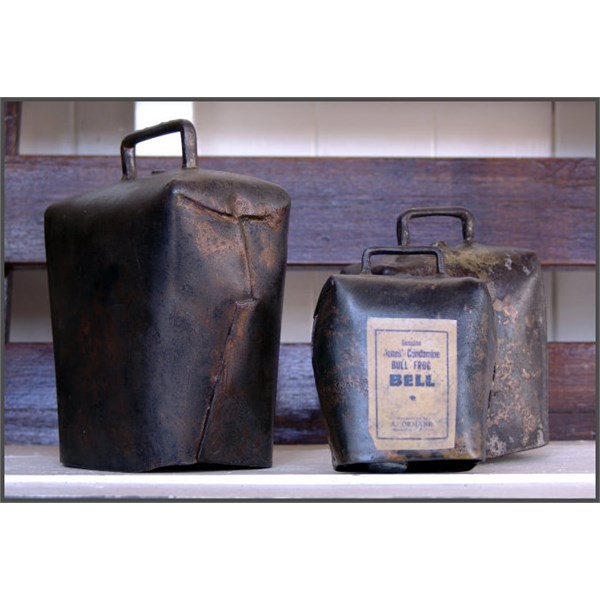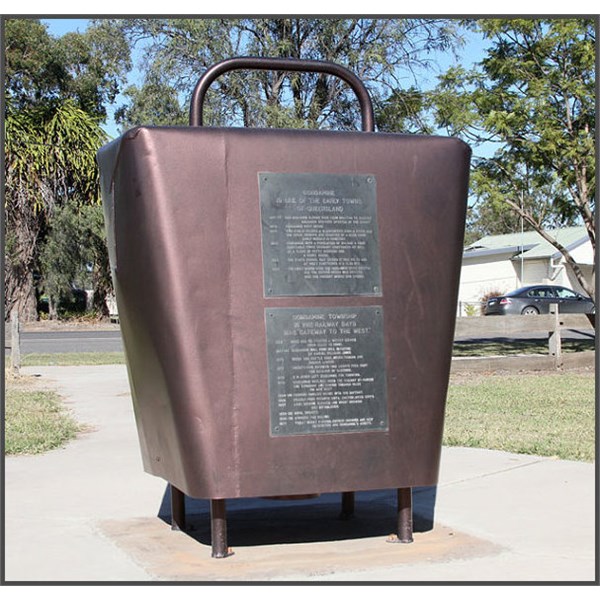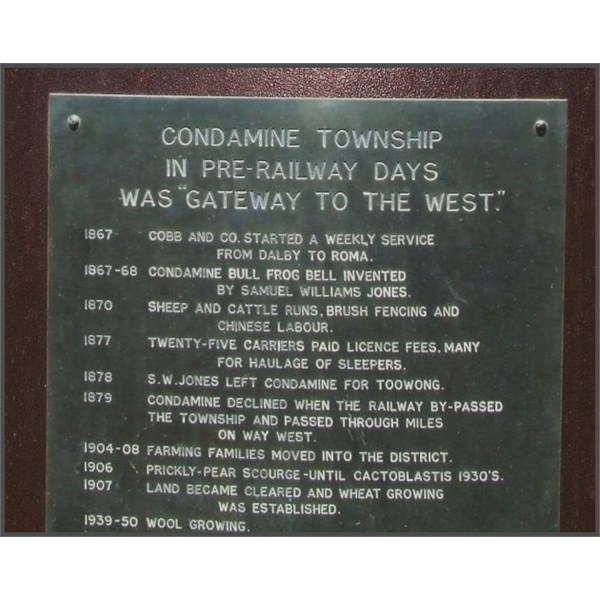In the early pioneering days of the last century when vast areas of land were unfenced, the bullock team was the only means of heavy transport to the newly settled areas.
Bullock bells were therefore a necessity in those times to enable the teamster to find his team after they had strayed from
camp or
homestead after having been unyoked overnight.
The greater the carrying sound of the bell, the better it was.

Samuel Williams Jones

condamine Bell and a Bullfrog Bell
Samuel William Jones was born in the village of Pontybat in Breckonshire, Wales, in 1838. He arrived in Queensland in the sailing ship "Wanatta" on 30 April 1862. He was a wheelwright by trade.
He first of all went to
Toowoomba, thence to
Dalby, where he married a Miss Emily Amos in 1867. He went to
Condamine in 1867, and their only child, a daughter, was born there in 1868. He carried on the trade of blacksmith.
After his marriage to Emily Amos, daughter of
Dalby carrier Jeremiah Amos, on 9th October 1865, Samuel Williams Jones established himself as a general blacksmith on the
Condamine River near the
Condamine township. Samuel became aware of the need for good quality animal bells and formed within his own mind a bell which was destined to become renowned throughout Australia.

The Condomine Bell Book Front Cover
A drover's request for a stock horse bell prompted Samuel to make his first bell from a discarded pitsaw the only suitable material he had on hand. He fashioned it while hot into a unique bell which when tuned to the correct pitch had a distinctive `knock' and was of clear tone.
While awaiting the drover's return the bell was hung at
the entrance of the `Smithy' where it soon attracted the attention of passing teamsters and drovers. The `
Condamine Bell' enterprise commenced early in 1868. In total 16 different sized bells were made.
After twelve years in
Condamine, Samuel, Emily and their daughter Gwendoline moved to Toowong mainly because of a decline in blacksmith work in
Condamine and the high freight and cartage costs added to his materials.
Charcoal used in his bellow-blown forges in Toowong came from Mr McLennan's Kenmore property.
Grey gum was most acceptable as it did not throw sparks. The
grey gum was snigged to the
creek, stacked for burning and after thorough cooling, bagged and delivered to Mr Jones.
Mr Alf Ormond, who assisted Samuel, continued with the manufacture of the
Condamine Bells following Samuel's death in 1927 aged 88. Ill health forced Alf Ormond to hand over the `Smithy' to his son who was still making
Condamine Bells in the 1970s.

The big Condamine Bell at Condamine

Plaque on The big Condamine Bell - top

Plaque on The big Condamine Bell - Bottom
In 1978 a replica bell was erected in a
Condamine park to mark the centenary of the
Miles district, dedicated to the memory of Samuel Williams Jones.
The first bells were made out of pit saw or cross-cut blades riveted and brazed, and fashioned in the semi-peg-topped shape, instead of the normal bell-shape which flares outward at the rim.
The true Jones bell was stamped on the tongue, and these bells today are greatly prized relics of an era which can never come again. The bells became so
well known that orders for them came from as far afield as Western Australia.
While Mr. Jones was in
Condamine he taught a Mr. Christie Andersen the method of making these bells, and Mr. Andersen also became famous as a maker of
Condamine bells. His bell was also stamped.
The true Andersen and Jones bells are few to find now, and the authenticity of an original is of course doubtful if it does not have the tongue intact and stamped with either of the makers' names.
Mr. Jones died in April 1927 at the age of 88 years, his wife having died in 1922. While in
Condamine he was assisted by Mr. Christie Andersen, and a Mr. Tom Beckett.
Mr. Andersen was born in Odense,
Denmark, on 3 January 1851. In 1871, at the age of 20, he came by sailing ship to Queensland, with his father, mother, three brothers and
three sisters. His father (Peter Andersen), who lived untU he was 92, first settled at Zillmere (then known as Zillmairs
Waterhole). Mr. Andersen was originally a nailmaker by trade. He was married in 1877. Mr. Andersen moved from
Condamine to
Miles, and had a sawmill on the Wallan in 1896. Mr. Andersen resided in the district for 42 years before leaving to settle in Beaufort Street, Alderley,
Brisbane, in 1919. In the
Miles District he was a sawmiller and carpenter as
well as a blacksmith. He had a sawmill at Paddy's
Creek, later moved to Wallan
Creek where "Christianberg" was the name of his property.
His blacksmith
shop in
Miles was located somewhere to the rear of where the
Miles Ambulance Centre now stands. Mr. Andersen died in 1937 at the age of 86. His wife died in 1925.
He continued to make bells in
Brisbane until a year or two before his death. His son Fred helped him and carried on after his death, until he was forced to stop doing so because of the shortage of the right materials.
A Mr. McLennan recalls that his father, who had a property at Kenmore, used to supply charcoal for the forge of Mr. Jones, when the latter was living in
Brisbane. Mr. Jones attached great importance to the quality of the charcoal which was the only fuel used in the process. He would not use charcoal which was burned in a pit, this being the normal method of producing it. Charcoal from ironbark was of no use as it threw too many sparks, and charcoal from spotted gum was also barred.
This meant that the logs of timber accepted by Mr. Jones, of which
grey gum was one, had to be snigged to the bank of a little
creek on Mr. McLennan's property, stacked in the open for burning and then at a certain stage
water was carried from the
creek to quench the flames, and after the rough cooling the charcoal was bagged and delivered to Mr. Jones.
Extra from NSW

Original Menneke Bell
The bell was made by August Augustus Menneke who was born in 1838 in Bakenem, Germany. He immigrated to Australia, arriving in New South Wales in about 1858. Immediately after serving an apprenticeship in the blacksmithing trade, he established his own business in North Wagga, next to the Black Swan Hotel in approximately 1867.

August Menneke
August remained in North Wagga for several years. By the 1870s, he had won fame, particularly for the goods he manufactured for bullock drivers. He had a perfect ear for the sound of a bell, and his bells had a clear tenor quality, which could be heard
miles away. These bells were used on a leader in a bullock team or on other stock so they could be easily located.
.